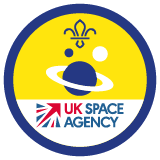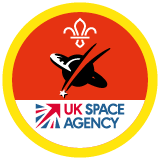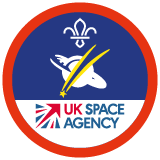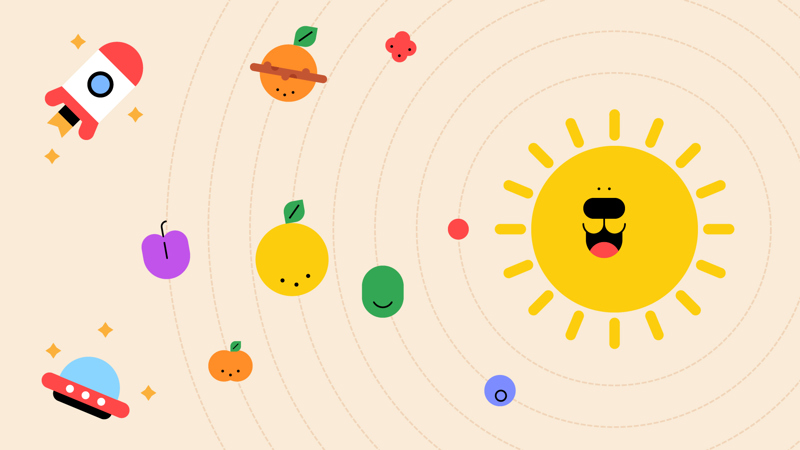
Create a fruit-salad solar system
You’ll need
- Bowls
- Baking trays
- Eight different fruits for each solar system (ideally raisins, blueberries, grapes, raspberries, grapefruits, oranges, small satsumas, and plums)
- Clear jugs of water
- Knives
- Chopping boards
- Skewers
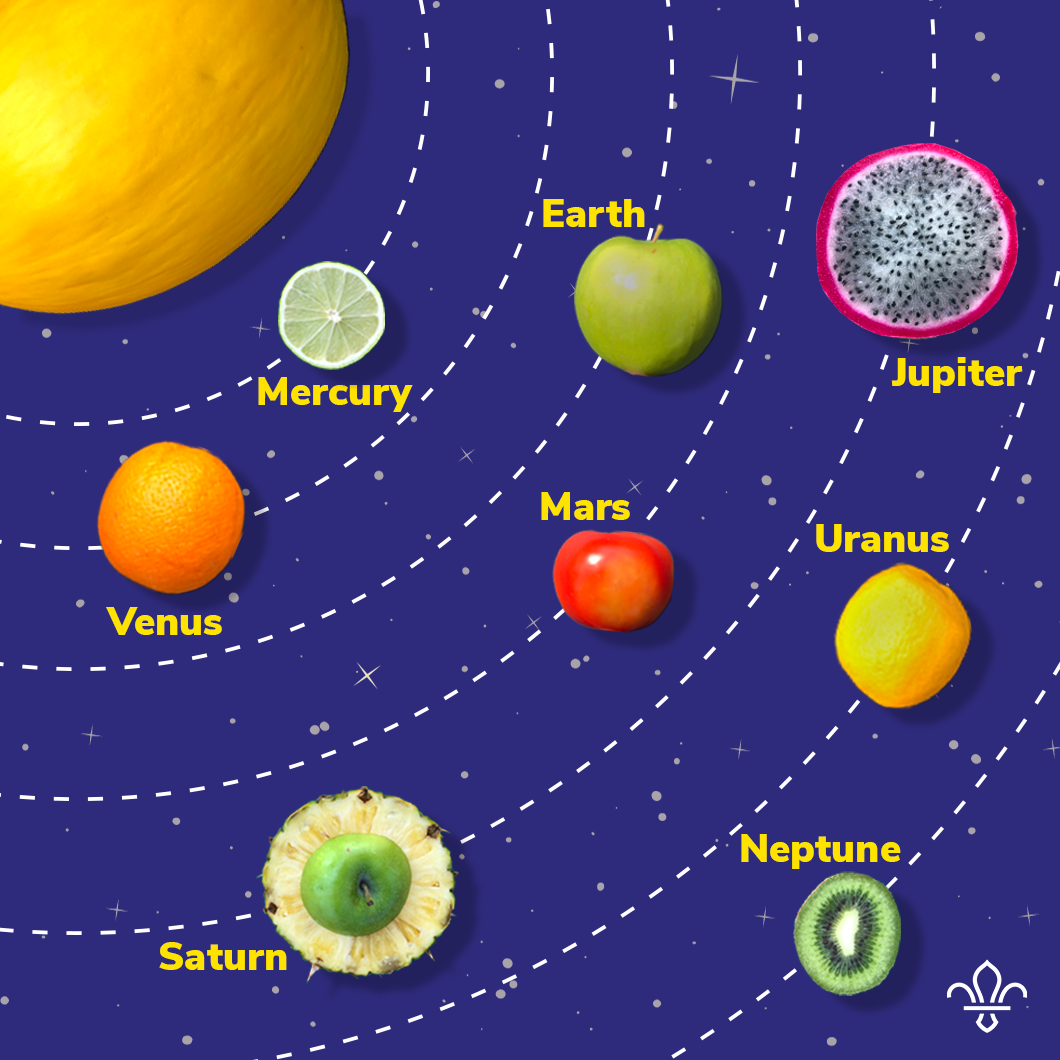
Before you begin
- Use the safety checklist to help you plan and risk assess your activity. Additional help to carry out your risk assessment, including examples can be found here. Don’t forget to make sure all young people and adults involved in the activity know how to take part safely.
- Make sure you’ll have enough adult helpers. You may need some parents and carers to help if you’re short on helpers.
Setting up this activity
- Put one of each fruit on a table or on the floor in the middle, so everyone can sit round it.
- It’s best to lay the fruit out in a group, not a line, so that you can build a clear solar system line later.
Build a group solar system
- Gather everyone around in a circle.
- Everyone else should sit so that they can see the fruits. Everyone should try and name the planets in our solar system, in whatever order they like. It’s okay if people can’t remember them all.
- The person leading the game should start with Mercury, as it’s closest to the sun. They should show the group what represents Mercury in the fruit salad solar system, which is the raisin. Place the raisin down in front of the other fruits, to one side, to start the solar system.
- Ask people to name the next planet. Whoever guesses it correctly should be told the fruit that represents that planet and place that fruit in the line. Keep doing this for all the planets.
- The planets and their fruits are Mercury (raisin) through Venus (blueberry), Earth (grape), Mars (raspberry), Jupiter (grapefruit), Saturn (orange), Uranus (small satsuma), and Neptune (plum).
- Depending on what's available you may want to choose different or seasonal fruits.
- The solar system shows how big the planets are compared to each other. However, it doesn’t show how far apart they are.
Build your own solar system
- Ask everyone to get into groups, and give each group one of each fruit.
- Each group should find a space, and set up their own Solar System.
- They should try to remember the order of the fruit planets, but they can check if they need to.
Test the planets’ density
- Gather everyone back together in a circle.
- Fill two jugs with water.
- Everyone should gather together into one group.
- Take Jupiter (a grapefruit) and Saturn (an orange).
- One person should stand behind each jug, holding either the grapefruit or orange.
- Tell everyone that both of these planets are made of hydrogen, but one will float and the other will sink.
- Ask people to point to the planet that they think will float.
- The people behind the jugs should gently place the fruit planets on top of the water.
- The grapefruit (Jupiter) should sink to the bottom of the vase or bowl. The orange (Saturn) should float on the water. This is because Jupiter’s gases are more densely packed (are squashed in closer together) than Saturn’s.
Use the fruit
- Everyone should bring the fruit back together.
- Ask everyone to wash their hands.
- Each group should wash the fruit.
- Next, with adult supervision, they should prepare it by peeling and chopping it.
- People should take a skewer.
- Next, pace one of each fruit on the skewer to represent each planet and create a mini solar system. You may want to have an adult supervise as people could chop each piece into the shape of the planet.
Starting big - the whole of space
The Universe includes everything we can and can’t see. We’re not sure how big it is, because not all of it contains visible light, so we can’t measure all of it. We do know that it’s 13.8 billion years old.
A galaxy is a large group of stars, held together by gravity. Our galaxy is called the Milky Way. One of the stars in the Milky Way is the Sun. Eight planets orbit the sun and make up our solar system. One of these planets is Earth, our home.
The planets in our solar system
Our closest neighbours are the rocky planets. Starting from the closest to the sun, they are:
- Mercury: Mercury is the smallest planet, and the closest to the sun.
- Venus: Venus spins in the opposite direction to all of the other planets in the solar system, and its surface is covered in volcanos.
- Earth: Welcome home to planet Earth. Did you know that three-quarters of our planet is covered with water?
- Mars: Mars is also known as the ‘red planet’. It gets its striking colour from a mineral called iron oxide, which covers most of its surface.
Beyond Mars are the gas giants. Still working outwards from the sun, they are:
- Jupiter: Jupiter is the largest planet in our solar system. It’s so big that all of the other planets in the solar system could fit inside it.
- Saturn: Saturn comes in second on the size scale, but tops the charts as the lightest planet, as it’s almost entirely made of gas.
- Uranus: Uranus is the coldest planet in our solar system.
- Neptune: Neptune takes its name from the Roman god of the sea, as it’s a deep blue colour. It’s roughly the same size as Uranus.
Remembering the planets
Some people find it easier to remember the order of the planets with a saying or rhyme (if you want to be fancy, these are called mnemonics). For example:
- My very easy method just speeds up naming
- Mum’s very easy map just shows you north
- Mercury’s volcanoes erupt mulberry jam sandwiches until noon.
Pluto
Until 2006, Pluto was considered to be the ninth planet in our solar system. In 2006, scientists decided on a clear definition of ‘planet’. Pluto didn’t meet all of these new criteria because it doesn’t have enough gravitational influence. Its orbit still has lots of small objects in, which Pluto hasn’t pulled in or pushed away. Pluto became known as a dwarf planet - it’s smaller than our moon.
The Sun
The Sun is a huge ball of gas. Continuous reactions generate a lot of energy. We receive some of this energy as light, and other forms of radiation. The sun is very hot - at the centre, its temperature is 15 million degrees. The closer a planet is to the Sun, the more heat and radiation it gets. We can live on Earth because it’s the perfect distance away from the Sun. We’ve evolved to live with the temperature and radiation.
Reflection
This activity helped you to develop skills. Which skills did you use in this activity? Did you learn any techniques to help you learn and remember things? What worked best for you? Did you practice any practical skills like chopping?
This activity also helped you to learn how to live healthily. Why is it important to eat a range of fruits and vegetables? Did you know all of the names of the fruits in your solar system? Had you tried any of them before? Which one is your favourite? Would you like to eat them again?
Safety
All activities must be safely managed. You must complete a thorough risk assessment and take appropriate steps to reduce risk. Use the safety checklist to help you plan and risk assess your activity. Always get approval for the activity, and have suitable supervision and an InTouch process.
- Sharp objects
Teach young people how to use sharp objects safely. Supervise them appropriately throughout. Store all sharp objects securely, out of the reach of young people.
- Food
Remember to check for allergies, eating problems, fasting or dietary requirements and adjust the recipe as needed. Make sure you’ve suitable areas for storing and preparing food and avoid cross contamination of different foods. Take a look at our guidance on food safety and hygiene.
You can tell the group as much information as they think is appropriate. Some people may want to know more than others. A volunteer or young leader could prepare all the fruit while the groups test the planets’ density, to speed it up.
Remember to check your ingredients against any allergy or dietary requirements to ensure everyone can enjoy the recipe. This may mean using alternative ingredients.
If someone’s struggling with the chopping or peeling section of this activity, they could work with a partner, so they can help each other.
No one has to use or to try every or any fruit. If people are only comfortable using certain fruits on their skewer, that’s OK.
All Scout activities should be inclusive and accessible.
